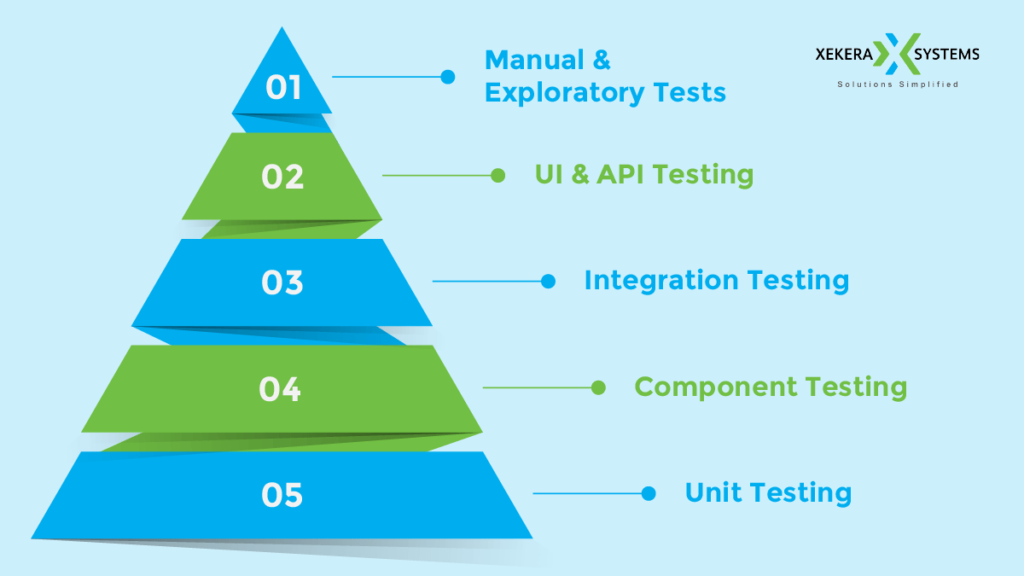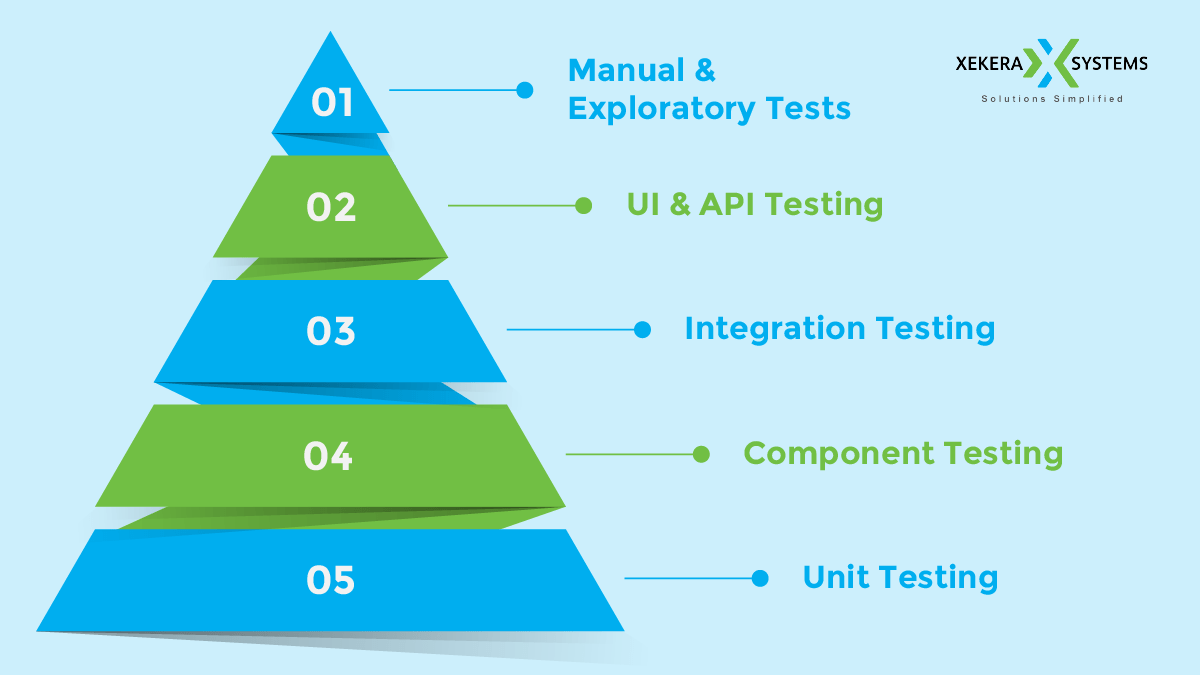Do your development teams spend a lot of time waiting for test suites to run? Contact us we have solutions for your problems. We Always rerun test suites after a failed test because “rerunning magically fixes the problem.” Are you running it? If your developers are having these issues, chances are your test suite doesn’t follow the test automation pyramid.
The Test Automation Pyramid is an important concept that every software developer should be familiar with. A framework that can help development teams create higher quality products. The test pyramid also reduces the amount of time it takes developers to see if they’ve introduced breakthrough changes. It also allows you to create more reliable test suites.
This post takes a deep dive into the test automation pyramid and presents some strategies for managing it.
Table of Contents
- Test Automation
- What is the Test Automation Pyramid?
- Unit Testing
- Integration Testing
- End-to-End Testing
- Conclusion

Test Automation
Before diving into the test automation pyramid, let’s define test automation. I’m not going to reinvent the wheel, so I’ll borrow the definition from the following blog post.
Test automation can automatically prepare and clean up the environment, reducing the time developers spend testing software. Not only that, but you can also report the results of your test runs that can be used for future insight. This allows developers to debug issues more quickly.
We live in a world where new information is available on an almost daily basis. The practices of Continuous Integration and Continuous Delivery have proven to be beneficial to businesses and are being adopted around the world. Having an efficient testing process is also important, as testing is an important part of this process.
Test automation plays an important role as it reduces the time spent on testing and improves accuracy.
Now that we know what test automation is, let’s see where the pyramid fits in.
What is the Test Automation Pyramid?
The Test Automation Pyramid represents different types of tests and how often they appear in a codebase test suite. This is to give developers immediate feedback that code changes do not break existing functionality. The test pyramid has three different sections. Unit tests are the lowest level, integration tests are the middle level, and end-to-end tests are the highest level.
The Test Pyramid helps developers deliver quality software.
Why should we distinguish between test types in our code base? Let’s break down the hierarchy to answer the question. It also defines some common tools at each level and offers some tips for managing the test automation pyramid.
Unit Testing
What is Unit Testing?
Our testing pyramid needs a strong foundation, and this is where unit testing comes into play. This means that it is the most common type of test in the testing pyramid.
What is a unit test? Unit testing focuses on testing a very small component or piece of functionality in your code base. The purpose is to verify that the device behaves as expected under isolated conditions. This can be a single function or a class. Developers should focus on testing different scenarios, from happy paths to error handling.
Toolset
Mocking frameworks such as Mockito for Java and Sinon for JavaScript are common tools found in unit testing layers. Mocks allow developers to control the behavior of components used by test subjects. For example, classes that rely on communicating with RESTful services can use the HTTP client library. Developers may want to mock the HTTP client to control the type of response returned by the web service.
Considerations
Unit test suites should run quickly. This is the largest subset of tests in the pyramid, and that number will continue to grow as new features are added. Every time a developer changes code, the unit test suite should be run. This gives developers instant feedback on whether their new code has broken anything in their code base. Rapid unit test suites encourage developers to run suites more often, reducing the time it takes to debug problems.
One way he builds a strong unit test suite is to practice Test Driven Development (TDD). Of course, you have to write your tests before your code, so TDD can lead to a powerful unit test suite. As new functionality is added, new unit tests are created.
Unit tests are great for testing small parts of your code base. However, unit tests are not representative of the deployed application. Also, the app’s interaction with the outside world is not tested. This is where integration tests come in
Integration Testing
What is Integration Testing?
Unit testing is not enough to ensure the quality of our codebase, so we are now introducing integration testing. Integration testing forms the middle level of the test automation pyramid. This means that integration tests shouldn’t be as general as unit tests. Integration testing is an overloaded and confusing term in the world of software development. Define integration tests as tests that verify interactions with external components. Let’s unpack it a little. An external component can be anything that is external to your application and on which your application depends.
Databases, for example, are very common external dependencies in software applications. It’s important to test that your application is interacting with the database as intended. Database integration tests should ideally be run against a real instance of your database that resembles your production environment. However, to do this, the database must be managed locally or in a build pipeline. Docker simplifies management by providing images for many popular databases, including MySQL and Microsoft SQL Server.
Integration with external services should also be tested. These types of tests are also called service tests. Service integration testing should focus on how your code interacts with external services such as RESTful APIs.
So why would a developer bother with unit tests when integration tests show that the code works with external dependencies?
Why do we need integration tests?
Are outside your app and the function you are testing may need to communicate with those dependencies. This can cause integration tests to run slower compared to unit tests because they call databases or web services. Also, if you want to test integrations with external web services, you need a pre-production environment to run your tests. Finally, it can be difficult to test all scenarios from an integration perspective. B. In the case of an error, because you have no control over the response from your dependencies.
End-to-End Testing
Finally, we are at the top of the test automation pyramid.
What is end-to-end testing?
Ultimately, we want to make sure that the entire application works as expected. End-to-end testing helps with that. End-to-end testing sounds like it. Test whether your application works from start to finish. In other words, test the frontend and backend integration.
I like to think of end-to-end testing from the perspective of the end user. How do users interact with my app? And how can I write tests from the user’s point of view? Let’s take an example. Our application probably has a login page. You may also want to test whether your login page works. This requires the following steps:
- Locate the Username text box and enter your username.
- Locate the password text box and enter your password.
- Click the Send button.
This can be a very time consuming and tedious process for developers to test every code change. Additionally, different developers may have different strategies for this manual testing. How can you make this process more manageable and reproducible?
End-to-End Testing Framework
Selenium is a testing framework that automates in-browser interactions. Selenium provides a domain-specific language that developers can use to write tests that interact with web applications running in a browser. You can use Selenium to write a test that walks you through the login process. This also shows that the integration works with UI and backend API. If you’re looking for a no-code or hybrid solution, you can try the tool.
End-to-end tests are at the top of the test automation pyramid because they are slow and very fragile. Also, like integration tests, they can rely on external dependencies that may not be trusted.
Importance from the Test Pyramid
Application complexity has come a long way. If you look at a typical modern application, you’ll see multiple features, API usage, and more. With this increase in complexity comes the complexity of testing applications. In addition, there is one more pitfall. The testing process should be fast so as not to slow down the deployment.
There are several factors to keep in mind when testing manually. Manual tests are slower, less accurate, and more prone to human error than automated tests
Also, you should test your application after each update. Also, sometimes you need to test the same function multiple times. It’s human nature to get bored with repetitive tasks. And boredom leads to ignorance and carelessness, which can lead to mistakes.
Addressing all these bottlenecks requires an efficient process, and the Testing Pyramid is just that. Test automation is like adding a sports engine to your car, and test pyramids are like adding a turbo. The test pyramid serves as a guide to achieving better test results with minimal effort. This greatly improves the testing process.
Best Practices
Described the test pyramid, its benefits, and the efficiency of the testing process. But is it enough to follow a test pyramid approach to arrive at the most efficient tier? Well, I think there is always room for improvement. The testing pyramid is effective, but there are many other things you can do to improve your testing. Here are some testing best practices:
- Plan and determine the scope of test cases and tests to be automated.
- Choose the right tool for your application.
- Prefer testing.
- Write clean test code
- Prepare test cases and scenarios with high-quality test data.
- Avoid duplication of tests.
- Include tests in the deployment pipeline.
- Consider exploratory testing so you don’t miss anything.
Summary
Now that you understand the concept of the Test Automation Pyramid, let’s summarize what we’ve learned.
- The Test Automation Pyramid is a framework that defines different types of tests and how often they appear.
- unit tests form the basis of the test pyramid. They should run frequently and run fast.
- Integration testing is the middle level of the pyramid. These tests focus on your code’s interactions with the outside world, such as databases and external services. End-to-end testing of the
- is at the top of the testing pyramid. They are written from the user’s point of view and should be tested to ensure that the entire application works from frontend to backend.
Now that you know what the test pyramid is, do you think your development team has a strong pyramid in their code base? If your team has a robust test pyramid combined with test automation, your development team will You can deliver features faster and with higher quality.



